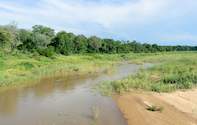
Kruger Park News Archive
The Kruger National Park has secured R3.6m over a three-year cycle that started in April last year for wetland rehabilitation in the Park. The money will mainly be used to break down old dam walls, which form an unnatural barrier within a wetland. The area immediately below the wall usually dries up and ultimately leads to the destruction of that part of the wetland.
All efforts were concentrated in the northern regions of the Park, specifically into breaking down the Stangene dam wall and the construction of 11 sets of culverts in the Levhuvhu floodplain close to the Levhuvhu River bridge. In the next financial year, the team will finalise the Stangene project, as well as demolishing the Mpenza damwall in the Far North.
They will also rehabilitate dongas in the Shangoni and Punda Maria areas. An additional R550 000 has been received from the Department of Environmental Affairs and Tourism, channelled through the South African National Biodiversity Institute, for erosion maintenance and the construction of a boardwalk at the Skukuza Picnic site this year.
The boardwalk will be wheelchair friendly and will have 10 interpretive points on the 250 metre stretch across the wetland at Lake Panic on the golf course. The interpretive trail will end at the nursery at a combined Working for Water and Working for Wetlands information centre. An ungulate is basically any mammal that has hooves. They are generally herbivorous.
Today there are two main types of ungulates
- Artiodactyla - these have cloven hooves and include the pig, cow, camel and antelope families. Hippos also belong to this order
- Perissodactyla - these have an odd number of toes and therefore an odd number of hooves. They include horses and zebras, rhinos and South American tapirs

